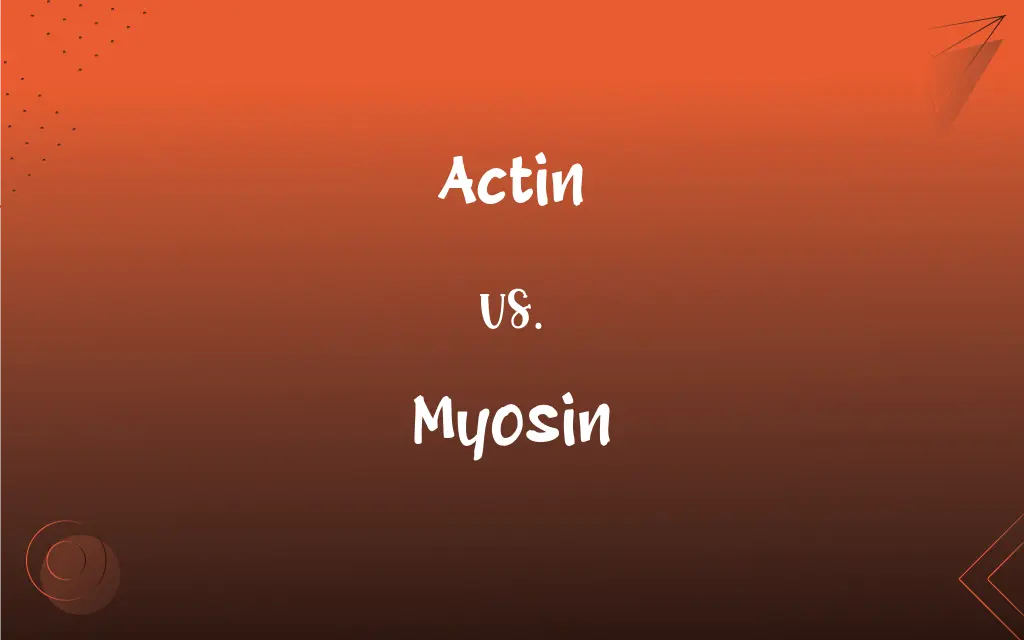Actin vs. Myosin: What's the Difference?
Edited by Janet White || By Harlon Moss || Updated on October 27, 2023
Actin is a thin filament protein in muscles, while myosin is a thicker filament that interacts with actin to cause muscle contraction.

Key Differences
Actin and myosin are both essential proteins in the muscular system, playing crucial roles in muscle contraction. Actin is a protein that forms the thin filaments of muscle fibers. Myosin, on the other hand, composes the thick filaments in muscle cells.
When muscles contract, the myosin filaments pull on the actin filaments, causing them to slide past each other. This sliding mechanism between actin and myosin filaments is the foundation of muscle contraction, enabling movement.
Structurally, actin is a globular protein, creating a helical chain in muscle fibers. Myosin, on the contrary, has a unique shape with a head and tail. The head region of the myosin molecule binds to the actin filament during muscle contraction.
In addition to their roles in muscle contraction, actin and myosin are also involved in various cellular processes. Actin is vital for cell shape and movement, whereas myosin functions as a motor protein, moving along actin filaments and transporting cellular cargo.
While both actin and myosin are fundamental to muscle function, their interaction is regulated by other proteins, ensuring precise and coordinated muscle movements. Any dysfunction in actin or myosin can lead to muscle diseases or other cellular anomalies.
ADVERTISEMENT
Comparison Chart
Function in Muscle
Forms thin filaments
Forms thick filaments and interacts with actin
Molecular Structure
Globular protein; forms helical chains
Has a head and tail; unique shape
Role in Contraction
Acted upon by myosin
Pulls on actin to cause contraction
Presence in Cells
Found in many cells; crucial for shape/movement
Motor protein in cells; moves along actin
Association with Diseases
Dysfunctions can lead to muscle/cell abnormalities
Dysfunctions can cause muscle diseases/cellular anomalies
ADVERTISEMENT
Actin and Myosin Definitions
Actin
Actin is a protein forming the thin filaments in muscle fibers.
Actin filaments are essential for muscle contractions.
Myosin
Myosin plays a key role in muscle contraction mechanics.
Without myosin, muscles would be unable to contract and produce movement.
Actin
Actin is involved in various cellular movements.
Actin fibers allow cells to move and change shape during processes like phagocytosis.
Myosin
Myosin has a distinct head and tail structure.
The head of the myosin molecule is responsible for binding to actin.
Actin
Actin plays a vital role in maintaining cell shape and structure.
Without actin, cells would lack stability and structure.
Myosin
Myosin is a protein that forms the thick filaments in muscle cells.
Myosin heads attach to actin filaments during muscle contractions.
Actin
Actin interacts with many other proteins to perform its functions.
Myosin binds to actin to facilitate muscle contractions.
Myosin
Myosin acts as a motor protein in cells.
Myosin moves along actin filaments, transporting cellular materials.
Actin
Actin exists in both monomeric (G-actin) and polymeric (F-actin) forms.
The polymerization of G-actin leads to the formation of F-actin strands.
Myosin
Myosin interacts with ATP to produce force and movement.
The hydrolysis of ATP by myosin provides the energy for muscle contraction.
Actin
A protein that forms the microfilaments of the eukaryotic cytoskeleton and plays an important role in cell movement, shape, and internal organization. In muscle cells, it functions with myosin to produce contraction.
Myosin
Any of a class of proteins that bind with actin filaments and generate many kinds of cell movement, especially the contraction of myofibrils in muscle cells.
Actin
A globular structural protein that polymerizes in a helical fashion to form an actin filament (or microfilament).
Actin
One of the six isoforms of actin.
Actin
One of the proteins into which actomyosin can be split; can exist in either a globular or a fibrous form
FAQs
How do actin and myosin interact?
The head of the myosin molecule binds to the actin filament, pulling it during contraction.
What are actin and myosin primarily known for?
Actin and myosin are essential proteins in muscle contraction.
What role does myosin play in muscle contraction?
Myosin pulls on actin, causing the filaments to slide and muscles to contract.
Can dysfunctions in actin and myosin lead to diseases?
Yes, abnormalities in actin or myosin can cause muscle diseases or cellular anomalies.
Are actin and myosin the only proteins involved in muscle contraction?
No, other proteins regulate and facilitate their interaction during contraction.
How is the actin-myosin interaction regulated?
Various proteins, like troponin and tropomyosin, regulate their interaction.
Where is actin located in muscle cells?
Actin forms the thin filaments in muscle fibers.
How is actin involved in cell movement?
Actin provides structural support and allows cells to change shape and move.
How do actin and myosin contribute to cell division?
They play roles in cytokinesis, helping to divide the cell into two.
Are there different types of myosin?
Yes, there are various myosin isoforms, each with specific functions in cells.
What role does calcium play in actin-myosin interaction?
Calcium binds to regulatory proteins, allowing myosin to bind to actin.
Why is understanding actin and myosin important?
Their function is vital for muscle movement, cell division, and other cellular processes.
How does myosin function as a motor protein?
Myosin moves along actin filaments, transporting cellular cargo.
Is actin only found in muscles?
No, actin is present in many cells, playing roles in shape and movement.
Are actin and myosin found only in muscles?
No, both proteins are also involved in various cellular processes.
What is the significance of the myosin head?
The myosin head binds to actin and uses ATP to produce force and movement.
What are the forms of actin?
Actin exists as monomeric (G-actin) and polymeric (F-actin) forms.
What is the structural difference between actin and myosin?
Actin is globular and forms helical chains, while myosin has a head-tail structure.
Do actin and myosin work independently?
No, their coordinated interaction is essential for muscle contraction and many cellular processes.
How is energy provided for the interaction between actin and myosin?
ATP provides the necessary energy for the movement of myosin along actin.
About Author
Written by
Harlon MossHarlon is a seasoned quality moderator and accomplished content writer for Difference Wiki. An alumnus of the prestigious University of California, he earned his degree in Computer Science. Leveraging his academic background, Harlon brings a meticulous and informed perspective to his work, ensuring content accuracy and excellence.
Edited by
Janet WhiteJanet White has been an esteemed writer and blogger for Difference Wiki. Holding a Master's degree in Science and Medical Journalism from the prestigious Boston University, she has consistently demonstrated her expertise and passion for her field. When she's not immersed in her work, Janet relishes her time exercising, delving into a good book, and cherishing moments with friends and family.































































